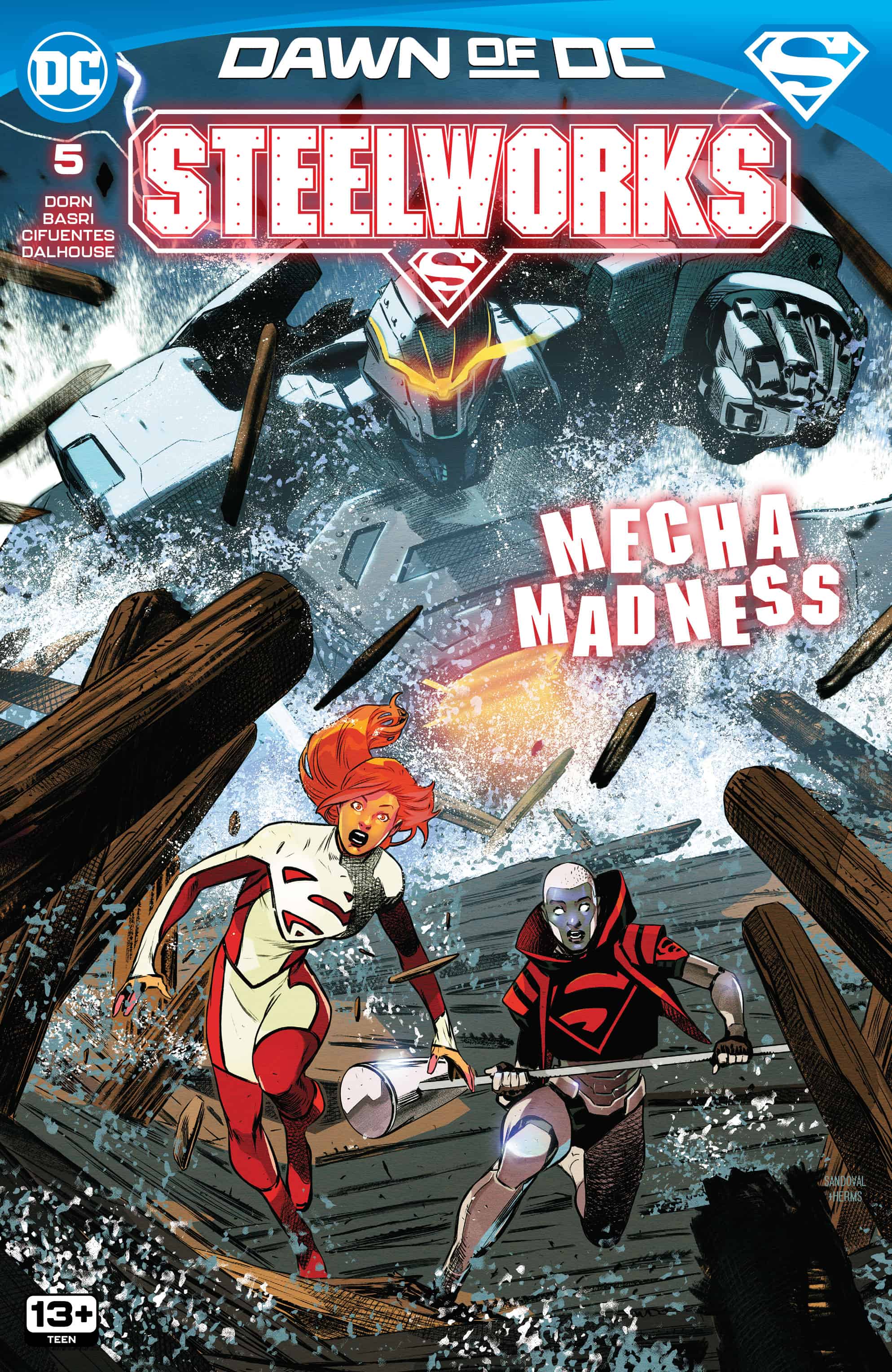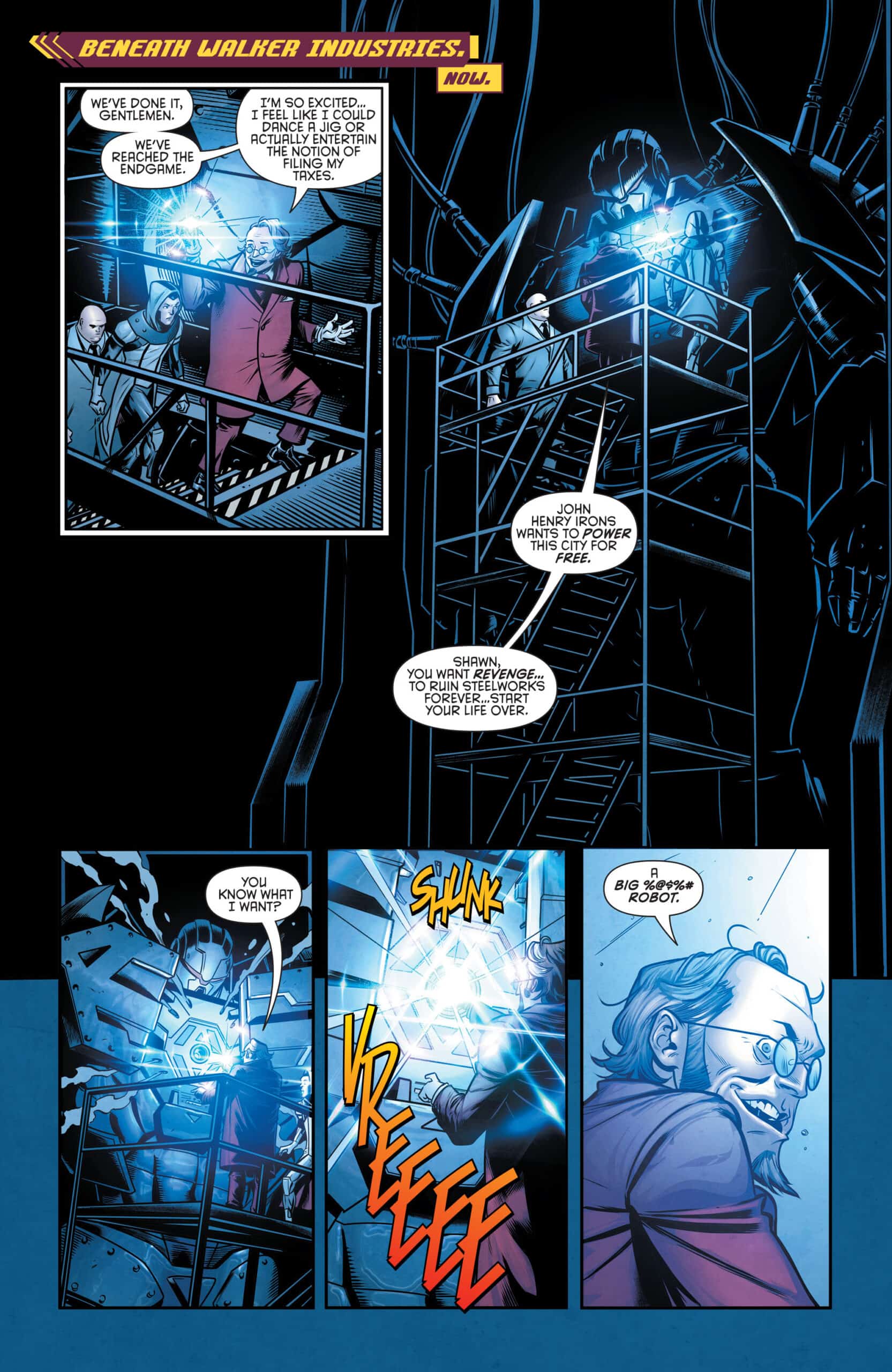Steelworks #5

Recap
THE PENULTIMATE CHAPTER HAS ARRIVED! Our heroes brace for impact as a startling new weapon emerges from deep beneath Hob's Bay to wreak havoc on Metropolis! As the fight for the future of the city nears its shocking final showdown, Steel and Superwoman's combined powers--and their engagement--will be tested like never before!
Review
Steelworks spent four issues on big-picture concepts. That’s not surprising when the main character wants to change the world. Small-scale personal stories weren’t crowded out completely, but they did stay mainly in the background. That all changes with Steelworks #5, which successfully boils the significant picture concerns down to very personal issues.
Walker is powering a giant robot with the stolen zero-point orb when Steelworks #5 opens. Walker’s revenge against John Henry Irons and Steelworks will come in the form of a robot attack on Metropolis. The issue cuts from the present to the past and reveals how Amertek fell. John Henry left for moral reasons, and his contract allowed him to take his inventions with him. Walker, a division manager at Amertek, burned the company’s money fighting John Henry in court. This led to staff getting let go, including Kerry. Kerry is low enough on the totem pole that he doesn’t seem to know why he was let go. Shortly after, Kerry’s wife falls ill. He no longer has insurance from Amertek. And when he is prepared to “accidentally” die in traffic so his life insurance pays off to help his wife, Kerry is saved by Steel. That’s when the issue cuts back to the future and the arrival of Walker’s robot.
Steelworks #5 delivers the classic “this is what happened” behind the events Walker described in the first issue. The truth weaves nicely with the lies Walker spun for Kerry’s benefit. The most compelling part by far is that Kerry doesn’t blame Steel for his wife’s death because John Henry left the company. There’s no evidence that Kerry even knew that’s what precipitated Amertek’s downfall. He also clearly didn’t know what Walker’s fundamental role in the company’s downfall was. For Kerry, it was more personal. Steel robbed Kerry of the opportunity to trade his life for his wife’s essentially.
This event harkens back to John’s plan as described in the first issue: to help the citizens of Metropolis help themselves. Indeed, he wasn’t talking about letting people kill themselves to solve problems. But Dorn creates an excellent sense of symmetry in showing that Steel’s meddling with Kerry’s actions led to (in Kerry’s eyes) his wife’s death. Steelworks #5 provides this background solely for our benefit, but it does raise the question of what Kerry might do if he learns the truth of Walker’s involvement.
These revelations also dovetail nicely into a scene where John Henry expresses his fear that, as Steel, he’s giving in to old-fashioned notions of being a hero rather than helping people on a more extensive scale work toward a better future. This is essentially what he did with Kerry. He was a “hero” in saving Kerry’s life, but that wasn’t what Kerry needed at that moment. And John didn’t wait around to find out what collateral damage resulted from his actions.
Steelworks #5 is most successful in these human moments, featuring Kerry and John Henry. This is what truly stands out in the issue. Walker’s giant robot, despite being a significant action set piece, is much weaker by comparison. It comes across almost as obligatory–the necessary hero/villain conflict that a superhero comic has to have. It lacks the weight belonging to the more personal scenes.
The robot sequences do provide the most visually exciting part of Steelworks #5. Basri and Cifuentes are more than up to the task of delivering action sequences between it and the Supers. The robot’s design is compelling. It sports a harsher, more straight-edged version of the Sworn by the Supers and Steel–a friendly visual reminder of their philosophical opposition.
The art is most impressive, though, in the character above scenes involving Kerry and John. This has been a strength in Steelworks all along. Facial detail is relatively minimal. Basri and Cifuentes don’t overload intricate linework to communicate emotions. Their power comes through depicting body language. A standout moment comes during the revelatory flashback when Kerry learns that his life insurance will pay out in the case of accidental death, and he makes his decision to step into traffic. The expression on his face is blank, which works for this moment. But Kerry’s head is also ever so slightly tilted, a bit of detail that suggests he is on autopilot and no one is home upstairs.
Dalhousie’s coloring likewise has a particularly standout sequence. He gives the flashback sequence a slight sepia tone that, at first, feels like a standard choice to delineate the past from the present. But once the flashback reaches the point of Kerry’s wife falling ill and Kerry attempting to kill himself, this coloring choice serves to fuel the tragedy.

Leigh’s dialogue lettering, while likely reflective of the script, emphasizes strong speech and critical ideas. The standard bold type works exceptionally well for the former, especially in the case of Walker’s dialogue, which frequently reflects his fury—but having established that use, it reads strangely in its subsequent function to highlight concepts and ideas. Varying the choice for these two dialogue components may have been more effective. Much more successful is Leigh’s sound effect work, which gets progressively more prominent as the issue goes on until Walker’s robot arrives.
Final Thoughts
Steelworks #5 is a huge issue in an already successful series. Eventually the story had to dig deeper into the motivations of its characters. This issue does that in spades.
Steelworks #5: What Makes a Hero?
- Writing - 10/1010/10
- Storyline - 9/109/10
- Art - 9.5/109.5/10
- Color - 9/109/10
- Cover Art - 8.5/108.5/10




